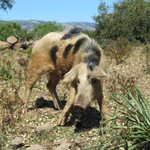Evolution

Neanderthal DNA sequences are more common in modern Africans than previously known, and different non-African populations have levels of Neanderthal ancestry surprisingly similar to each other, according to a new study in Cell.
Researchers arrived at these findings by developing a new statistical method, called IBDmix, to identify Neanderthal sequences in the genomes of modern humans. The results also suggest that African genomes contain Neanderthal sequences in part due to back-migration of ancestors of present-day Europeans.
Past studies have suggested that East Asians have…

The Handmaid’s Tale is a TV series based on the 1985 novel of the same name by Margaret Atwood that presents a dystopian vision of a male-dominated society known as Gilead.
Widespread infertility means that the few fertile women who remain have been enslaved as handmaids and assigned to Gilead’s leaders to produce their future offspring. The series follows the struggles of June, who was separated from her family and forced to become a handmaid.
But just what is a reference to the evolutionist Charles Darwin doing in an episode of The Handmaid’s Tale?
‘The Handmaid’s Tale’. (Shutterstock…

The evolution of the snake body has captivated researchers for a long time because it represents one of the most dramatic examples of the vertebrate body's ability to adapt. A limited fossil record has obscured our understanding of their early evolution but now an ancient legged snake, called Najash has shed light on the origin of the slithering reptiles.
The fossil analyses reveal they possessed hind legs during the first 70 million years of their evolution, and provide details about how the flexible skull of snakes evolved from their lizard ancestors.
Scientists performed high-…

Though homosexual behavior has been rewarded in over 1,000 organisms, it can be an evolutionary puzzle; since reproduction can't happen, there is a fitness cost, so why do it?
A new paper argues it's part of the ancestral condition in animals and that evolutionary biologists need to relax their traditional constraints on evolutionary theory. They also dispute the assumption that because different-sex behaviors are essential for sexual reproduction selection — or the tendency of beneficial traits that promote increases in population, size, or resilience — will eliminate sexual behaviors that…

Few topics arouse as much interest and controversy as sex. This is hardly surprising. The biological continuance of the species hinges on it – if human beings stopped having sex, there would soon be no more human beings. Popular culture overflows with sex, from cinema to advertising to, yes, even politics. And for many, sex represents one of the most intimate forms of human connection.
Despite its universality, sex and its purpose have been understood very differently by different thinkers. I teach an annual course on sexuality at Indiana University, and this work has provided opportunities…

One of biology's most fundamental sets of building blocks may have special properties that helped bootstrap itself into its modern form - or it may be "cui bono?" thinking where people find an event, find a fact, and assume the fact caused the event, like we get in endocrine disruption and too much modern epidemiology.
All life, from bacteria to blue whales to human beings, uses an almost universal set of 20 coded amino acids to construct proteins. This set was likely "canonicalized" or standardized during early evolution; before this, smaller amino acid sets were gradually expanded as…

Discovery of a "remarkably complete" cranium (MRD-VP-1/1, shortened to MRD) in February 2016 from a 3.8-million-year-old early human ancestor from the Woranso-Mille paleontological site, located in the Afar region of Ethiopia, represents a time interval between 4.1 and 3.6 million years ago when early human ancestor fossils are extremely rare, especially outside the Woranso-Mille area.
The 3.8-million-year-old MRD specimen was buried in a river delta on the margin of a lake that formed in an actively rifted landscape with steep hillsides and volcanic eruptions that blanketed the land…

Having one of the most powerful bites in the animal kingdom, crocodiles must be able to bite hard to eat their food such as turtles, wildebeest and other large prey. Well, so do we, but we don't have exceptionally tough teeth and neither do crocodiles.
However, we do have relatively thick enamel on our teeth, which can get ruined over time without proper care.
Crocodiles don't even have that. They have thin tooth enamel, the opposite of humans and other hard-biting species, as their plant-eating ancestors did. But unlike humans, when their teeth go bad, they seem to just…

Ancient pigs went through a complete genomic turnover after they arrived in Europe, according to a new study. They were domesticated in the Near East and logically would genetically resemble the Near East wild boar from which they derived, but they do not.
Instead, they resemble European wild boar.
The work involved sequenced DNA signatures from more than 2,000 ancient pigs including genomes from 63 archaeological pigs collected across the Near East and Europe over the last 10,000 years.
The findings revealed that the first pigs to arrive into Europe alongside farmers 8,000 years ago had…

Mammals living in diverse types of environments, from ocean swimmers to mountain dwellers, have a diverse variety of protective skins adapted to the elements and now one of the largest comparative genomic studies to help determine the key molecular and evolutionary origins of mammalian adaptations seen in skin proteins found which genes, among the dozens of mammalian keratin genes, are required for living on land or in the sea.
The products of these keratin genes assemble to form the girders of the cytoskeleton in skin cells, called keratinocytes, that maintain a tight barrier between the…